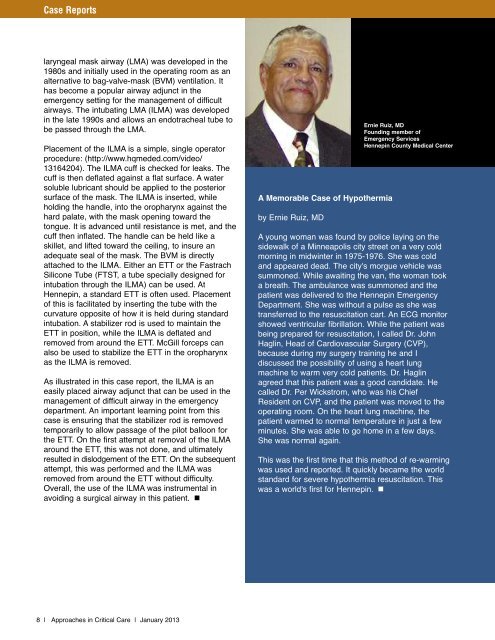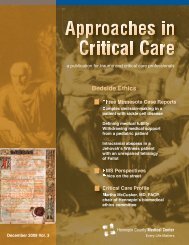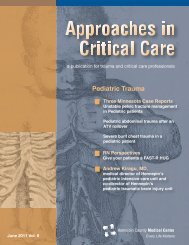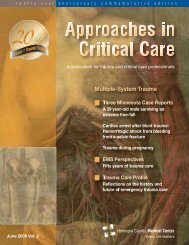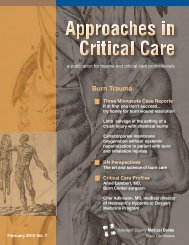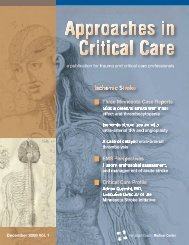HCMC_P_049062 - Hennepin County Medical Center
HCMC_P_049062 - Hennepin County Medical Center
HCMC_P_049062 - Hennepin County Medical Center
Create successful ePaper yourself
Turn your PDF publications into a flip-book with our unique Google optimized e-Paper software.
Case Reports<br />
laryngeal mask airway (LMA) was developed in the<br />
1980s and initially used in the operating room as an<br />
alternative to bag-valve-mask (BVM) ventilation. It<br />
has become a popular airway adjunct in the<br />
emergency setting for the management of difficult<br />
airways. The intubating LMA (ILMA) was developed<br />
in the late 1990s and allows an endotracheal tube to<br />
be passed through the LMA.<br />
Placement of the ILMA is a simple, single operator<br />
procedure: (http://www.hqmeded.com/video/<br />
13164204). The ILMA cuff is checked for leaks. The<br />
cuff is then deflated against a flat surface. A water<br />
soluble lubricant should be applied to the posterior<br />
surface of the mask. The ILMA is inserted, while<br />
holding the handle, into the oropharynx against the<br />
hard palate, with the mask opening toward the<br />
tongue. It is advanced until resistance is met, and the<br />
cuff then inflated. The handle can be held like a<br />
skillet, and lifted toward the ceiling, to insure an<br />
adequate seal of the mask. The BVM is directly<br />
attached to the ILMA. Either an ETT or the Fastrach<br />
Silicone Tube (FTST, a tube specially designed for<br />
intubation through the ILMA) can be used. At<br />
<strong>Hennepin</strong>, a standard ETT is often used. Placement<br />
of this is facilitated by inserting the tube with the<br />
curvature opposite of how it is held during standard<br />
intubation. A stabilizer rod is used to maintain the<br />
ETT in position, while the ILMA is deflated and<br />
removed from around the ETT. McGill forceps can<br />
also be used to stabilize the ETT in the oropharynx<br />
as the ILMA is removed.<br />
As illustrated in this case report, the ILMA is an<br />
easily placed airway adjunct that can be used in the<br />
management of difficult airway in the emergency<br />
department. An important learning point from this<br />
case is ensuring that the stabilizer rod is removed<br />
temporarily to allow passage of the pilot balloon for<br />
the ETT. On the first attempt at removal of the ILMA<br />
around the ETT, this was not done, and ultimately<br />
resulted in dislodgement of the ETT. On the subsequent<br />
attempt, this was performed and the ILMA was<br />
removed from around the ETT without difficulty.<br />
Overall, the use of the ILMA was instrumental in<br />
avoiding a surgical airway in this patient. <br />
A Memorable Case of Hypothermia<br />
by Ernie Ruiz, MD<br />
Ernie Ruiz, MD<br />
Founding member of<br />
Emergency Services<br />
<strong>Hennepin</strong> <strong>County</strong> <strong>Medical</strong> <strong>Center</strong><br />
A young woman was found by police laying on the<br />
sidewalk of a Minneapolis city street on a very cold<br />
morning in midwinter in 1975-1976. She was cold<br />
and appeared dead. The city's morgue vehicle was<br />
summoned. While awaiting the van, the woman took<br />
a breath. The ambulance was summoned and the<br />
patient was delivered to the <strong>Hennepin</strong> Emergency<br />
Department. She was without a pulse as she was<br />
transferred to the resuscitation cart. An ECG monitor<br />
showed ventricular fibrillation. While the patient was<br />
being prepared for resuscitation, I called Dr. John<br />
Haglin, Head of Cardiovascular Surgery (CVP),<br />
because during my surgery training he and I<br />
discussed the possibility of using a heart lung<br />
machine to warm very cold patients. Dr. Haglin<br />
agreed that this patient was a good candidate. He<br />
called Dr. Per Wickstrom, who was his Chief<br />
Resident on CVP, and the patient was moved to the<br />
operating room. On the heart lung machine, the<br />
patient warmed to normal temperature in just a few<br />
minutes. She was able to go home in a few days.<br />
She was normal again.<br />
This was the first time that this method of re-warming<br />
was used and reported. It quickly became the world<br />
standard for severe hypothermia resuscitation. This<br />
was a world's first for <strong>Hennepin</strong>. <br />
8 | Approaches in Critical Care | January 2013


